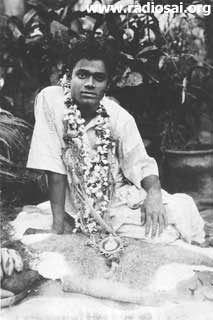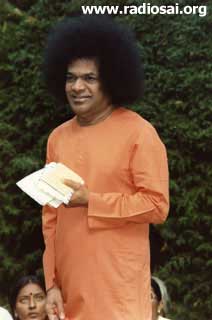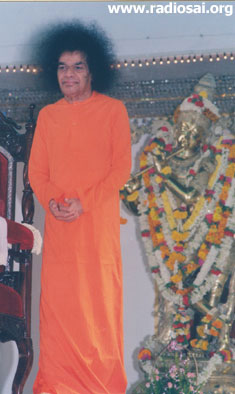| |
THE GOA INCIDENT
H (Hislop): Baba's dramatic recovery from what the doctors considered as sure death, during the Goa incident, must have amazed and puzzled the doctors?
SAI: The next morning, after Baba had at 4 p.m. walked down the 150 steps from the palace to the platform from which He delivered a spiritual discourse, there was a conference of the 25 doctors who had been called by the Governor to consult over Baba, along with quite a number of their medical students. The argument was ‘How could a body with a ruptured appendix and without operation continue to live?’ The top doctor said, 'We are in a useless discussion. Sri Sathya Sai is divine'. Baba created 25 rings all at once, one for each doctor. They have now all surrendered to Baba, and they call 'Sai Ram' before treating any patient. The radio reported Baba as dying. The best doctors in India were called in. Baba was black in colour. The doctors gave Him varying times of up to maximum of ten minutes or so to live. Baba then declared that He would lecture in the afternoon, and that He had taken on the illness of a devotee. India 's most prominent doctor said, 'That may be so, but I say you are about to die.’ Baba said, 'See at 4 p.m.'
STORIES FROM SWAMI’S CHILDHOOD
|
|
H: Is it true that Swami suffered some extreme abuse from doctors when He was a boy?
SAI: Baba underwent torture at the hands of the village doctors when He first allowed His divine powers to manifest on a fairly large scale. This was around the age of 10. The doctors drilled holes in His head and stuck in hot irons, cut open His skin and poured in burning fluids, buried Him in a trench with sand up to His neck and used iron bars to keep Him fixed in position. Here, He would just move and be free despite the iron bars. During all the torture, He smiled and felt no pain. He at no time had even the slightest body identification. When Baba was born, He knew His divinity and that He was God Himself. The universe is held in Baba's hand and He could in an instant, make the entire universe vanish.
H: Swami, please say some things about the early childhood?
SAI: Swami had two shirts and pants to last a year. There was no money even for a pin - thorns were used to hold torn places together. Tears in the cloth came from schoolmates who would punish Baba for always knowing the answers at school. Only He would know the answer. If He gave the answer the boys would beat Him. If He did not give it, the teacher would beat Him. On some occasions, the pupil who answered had to slap the faces of those who did not. Since Swami was small, He had to stand on a chair to slap. But He would slap gently. Then the teacher would slap Him hard as many times as he Had slapped gently. |
Of course, after the immediate retaliation on the boys, they would be loving and affectionate to Baba. Even though Baba had not even a pin for Himself, He would produce pens, pencils, notebook, paper, or whatever the boys needed. This, at length, led to some fear in the village. Because, how could it be explained to the authorities as to how these things were present? At one stage, after the age of 11, Baba was kept more or less out of circulation for a couple of years. At that time the liberation of India was in process, the police were moving in the villages and arresting Congress members, and so on.
H: The early stories are extraordinary! They do not conform to anything we could imagine. Those childhood companions, they must have been quite special. Was their further destiny unusual also?
SAI: In the school, there were two boys who sat with Swami in the same seat. It was for three. When Swami declared that He would no longer go to school, one boy committed suicide. The other boy went mad. He would call, 'Raju Raju’ all the time. At length he died.
H: It is very strange. A great mystery. But his death was a good death because his mind was fixed on Swami and constantly calling Swami's name?
SAI: He merged with Me. There was also a Telugu teacher who took pains to get himself appointed to Swami's school, and who left the school as soon as Swami left. |
|
|
THE PLACE OF EXERCISE IN ONE’S LIFE
A Visitor: Is an exercise programme important? In the West, exercise is considered to be of great value.
SAI: Exercise is extolled in the West as a way to digest excess food and sublimate the sex drive. Swami who is completely removed from the area of sensory thoughts, takes a very small quantity of food, and needs no exercise. Yet this body is very strong. For those engaged in work, there is exercise. The idea of exercise comes to those who are idle and who do not have the full responsibility of work. Moderation in life is necessary, otherwise there is no reserve of energy. Food must be in the body for some time for the benefit of the energy reserve. Too much exercise uses up the food energy before it can be added to the reserve. So there is no gain. Likewise, the human system cannot withstand too much talking. One M.P. talked for two hours and felt dizzy. Nobody can continue talking - that is, nobody except Swami who has been doing it for years and years.
H: Swami, hippies are seen wherever one goes. It is difficult for an older person to relate to that sub-culture. It does not seem to express values that can be taken seriously.
SAI: The hippie ideas are based on no work, drugs, begging, and free relationship between the sexes. Baba gave some of them work to do in the print shop. They did not do it. Baba offered funds to go home, they did not want to go. They do not understand 'karma', that work produces results, as it is understood in India. Dharma does not have an equivalent word in English. Righteousness is work. Truth in words, and truth and Iove in the heart is dharma.
‘FEEL ANOTHER’S HUNGER AS YOUR OWN’
H: How does one determine the particular dharma appropriate to himself?
SAI: One has to enquire. Ask questions such as, 'I am a man, what is animal work? Am I male or female? Am I young or old?' And so forth. Because animal behaviour is not correct for humans. And a man should not behave like a woman. If an old person plays with dolls, like a child, he is ridiculous. If a youngster takes a cane and walks like an old person, he is ridiculous. That work which is righteous, true, well-considered in truth, is dharma. Thought, word and deed must coincide. The other person must be understood. Do you feel hunger if another person is hungry? You must feel his hunger as your own.
|
|
H: When does one really experience that he is the same as another? Because now, one feels for another through compassion. But compassion is not direct experience. When someone hit a dog, Shirdi Sai Baba had bruises. That is the actual experience of unity.
SAI: All is divine. When you are firmly established in the fact of your divinity, then you will directly know that others are divine. Compassion for others is felt as long as you consider yourself as a separate entity. The story about Shirdi Sai Baba as related in books is not fully correct. The facts are that a lady made a plate of sweets for Shirdi Baba, and a dog ate them. The lady drove the dog away with blows. She then carried another platter of sweets to Shirdi Baba, who refused them, saying that He had eaten the sweets she previously provided and His hunger was satisfied. The lady objected that this was the first time the sweets had been offered, so how could Baba say to the contrary? Baba said, 'No', that she had offered them before and had also beaten Him. In this way, He gave a lesson that He was omnipresent and that there was only one life.
During the lifetime of Shirdi Baba not much attention was paid to Him. Recognition of Him as an Avathar, and interest in His life developed only after His 'death'. Thus, various incidents are recalled from memory now by devotees and written down in books. The same lack of recognition of divinity is illustrated in the lives of Rama and Krishna. Krishna was considered as just a cow-herd boy, and then as just a charioteer. Even the life of Shirdi Baba prior to age 18 is known only to Baba, and the divinity was known only to a very few genuine devotees. |
RECOGNISING THE AVATHAR
H: It seems strange that only a few people recognize the Avathar.
SAI: No, not strange. How would you know the Avathar?
H: By faith.
SAI: Faith is one thing, knowing is another. Your wife may have faith in you, but she does not also know you. The Avathar may be known at one time, but doubt arises and recognition wavers. An example is Viswamitra, the great sage, who asked for the company of the young lads Rama and Lakshmana, to help him overcome the demons who were disrupting his performance of Vedic ceremonies. He said to the King that he did not want the King's powerful armies, that the two boys, who were divine incarnations, were sufficient. Yet, upon reaching their destination, he called Rama in order to instruct Him in mantras that would overcome the demons. Waves of maya make recognition of the Avathar almost impossible.
H: But Swami, that is still very strange. Recognition of the Avathar was so difficult in those ancient, simpler days, yet in this corrupt and complicated society, recognition of the Avathar is almost world-wide.
SAI: Is it widespread? There are stories and articles about Swami, but how many persons are sure that He is the Avathar, and how many of those who are sure are free of doubt? Another example: you know Swami as the Avathar?
H: Yes.
SAI: No doubts?
|
|
|
H: No doubts whatsoever.
SAI: Your own experience is that Swami is omnipresent.
H: Yes, that is my direct experience.
SAI: Yet, when you leave Swami at Brindavan and arrive at your hotel you think of Swami as being at Brindavan. You see, it is not so easy to know the omnipresent Avathar. Of course, there are always some who know. In the Krishna Avathara there were some who knew. Likewise, there were some who knew the Rama Avathara. Not every blossom opens to the sun when it rises. Only some are ready. There is the factor of ripeness. Not every fruit on a tree is ripe at the same time. Another example: who offers that new house, and to whom is it given?
H: To the divine form.
SAI: What? Divine form. This is the divine form? This is a human body. When the name of Swami is placed on a transfer deed, to whom is the deed transferred, and who makes the transfer? Is it not from that body to this body?
H: Yes, from body to body.
SAI: Exactly. (The implication being that if Swami were really recognized as the Avathar, both offer and question of acceptance would have no meaning, and neither would occur.)
(To be continued...)
– Heart2Heart Team

|
|







